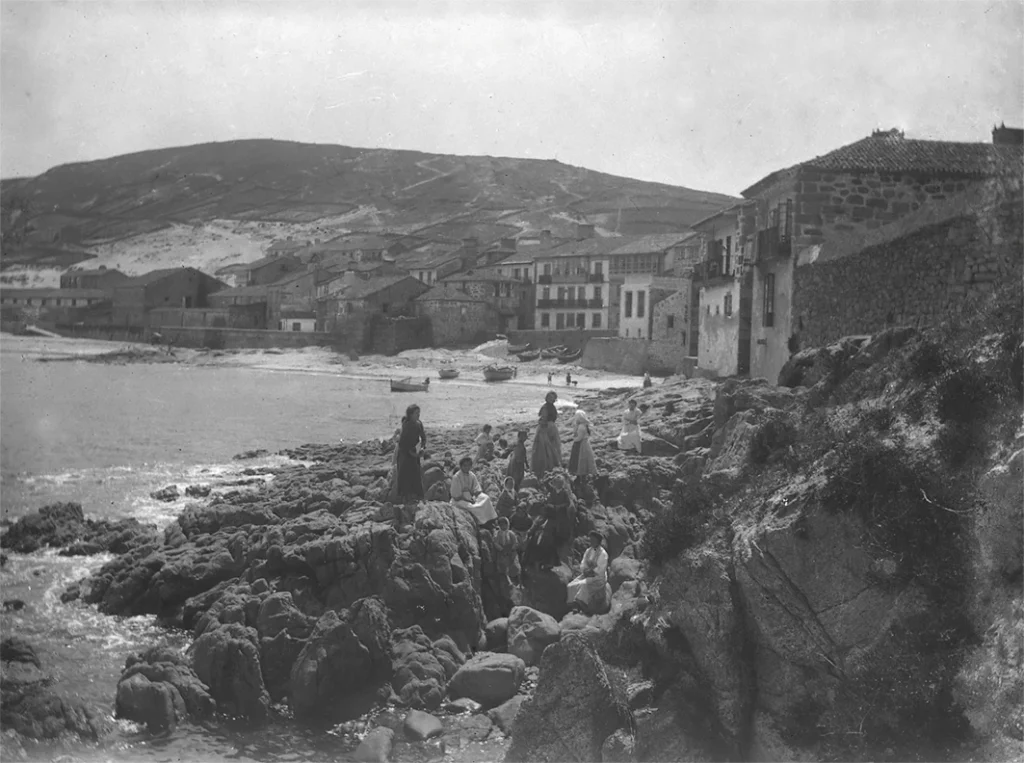
History
The location of Laxe (1,700 inhabitants) has certain similarities to Muxía: both are on a peninsula in the south side of a ría and next to a beach that acts as a natural jetty, although Laxe is more protected from the southerly and easterly winds.
The little space available for farming meant that fishing was the main activity for the town’s residents.
Malpica, Muxía and Fisterra were under the dominion of the archbishop of Santiago, while Laxe, Camariñas and Corcubión answered to the lay nobility, in this case the powerful Moscoso family, counts of Altamira and owners of the castles of Mens and Vimianzo. Laxe was under the jurisdiction of Vimianzo and historically functioned as the port of Soneira.
Casa del Arco, the oldest manor house in the town, belonged to the Moscosos, who also ordered the construction of the parish church of Santa María da Atalaia in the late 15th c., at the initiative of Urraca de Moscoso, executing one of the last wishes of her mother Juana de Castro y Lara.
Juan Molina mentioned the importance of Laxe as a fishing port in the mid-16th c., commenting on the large quantities of hake and conger caught there. The second half of the 18th century saw the arrival of the Catalans, attracted by the large schools of sardines in the ría. The Domènech family established a sardine salting factory in the port and went on to have a major social and political influence on the town.
In the 19th c., the decline of the Altamira family led to the Casa del Arco and the castle of Vimianzo falling into the hands of the Martelos. The Casa del Arco was later owned by the Doménech family. The first mayor of the constitutional municipality of Laxe was a member of the same family.
Like many other ports on the coast, Laxe was raided by pirates. English pirates attacked the town in 1748 and stole the most valuable articles from the parish church.
In the late 19th c., Laxe was a town with about one thousand inhabitants. The houses of the town extended from north to south, parallel to the coastline, including the parish church at the highest point with its bell tower. The plaza was located in the centre of the town, where much of its economic and social life took place. In the early 20th c. there were as many as five salting factories facing the beach that employed mostly women. The kaolin mine that started operations in the 1920s also played an important economic role in the town. Besides the fishing industry, the improvements made to the port in the postwar period turned the port into an important commercial harbour for products such as kaolin and timber.
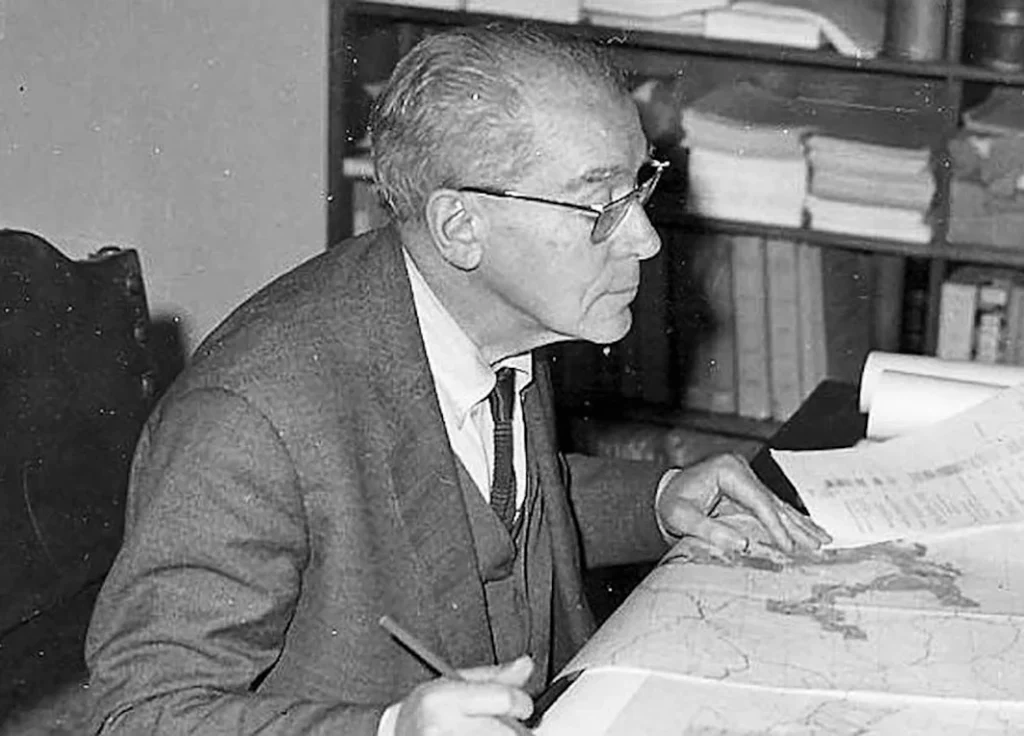
The famous people of Laxe include the photographer José Vidal García (1900- 1986), who left a visual testimony of the landscapes and people of Laxe and the surrounding area. Another figure was the geologist Isidro Parga Pondal (1900-1986), lecturer at the University of Santiago, who was removed from his post after the military rebellion of 1936. He founded the Geological Laboratory of Laxe, where students from several European countries came to study. The poet Antón Zapata García (1866-1953) emigrated as a young man to Buenos Aires, where he became involved in a wide range of cultural activities. His poetry was inspired by the landscape and sea of his native village.
Route on foot around the town
The urban route that we propose for Laxe matches the circular 1.6 km tour proposed by the municipality. It’s available on the municipal website and includes a street map, while our proposed route has a bit more information. Start the tour at the promenade, next to the panels with information about the municipal hiking trails. Head towards the parish church until you come to the Praza de Ramón Juega. This space is open to the sea and is the centre of the commercial and social life of the town. The most important building here is the Casa do Arco, named after the ogival arch that gives access to the Rúa Real. It may have been commissioned by Urraca de Moscoso and her husband Pedro Osorio in the 15th c. Although their main residence was in the city of Santiago, they would spend time in the castle of Vimianzo and in this house when they visited their properties in the area. The family owned it until 1870, when María Luísa Osorio de Moscoso sold the castle of Vimianzo and the Casa do Arco to Ramón Martelo Núñez, who was a member of the land-owning family of O Pombal from Boaño (Traba de Laxe) and also descended from the Moscosos on his mother’s side.
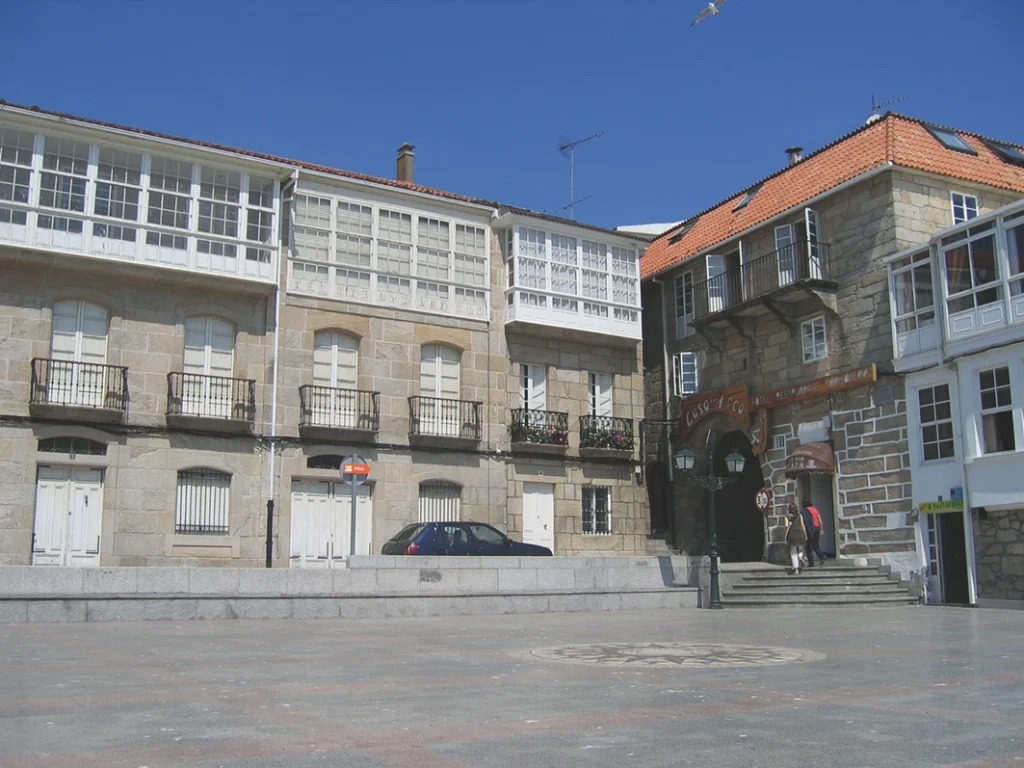
His son, the poet Evaristo Martelo, sold the house to the Domènech, a family of Catalan traders and developers, who settled in Laxe. The next owner of the Casa do Arco was Ernesto Pons, who sold it to Calixto Añón Vazquez, who opened a hospitality business on the premises.
The building is a large one, with three floors, a hipped roof and little in the way of decoration. The most attractive façade is the one facing the plaza, but the main entrance is on the west side between two chimneys. The only notable feature of the façade is a balcony on the third floor that rests on four corbels.
There is an old coat of arms of Galicia underneath the arch and to the left, with the chalice and host and an inscription in Gothic script. There is another coat of arms with a wolf’s head, a symbol of the Moscosos, and the six roundles of the Castros, a reference to the previous owners of the house.
The houses with balconies and galleried landings that close off the plaza to the west were built in the second half of the 19th c. by members of the local bourgeoisie. One of them belonged to the family of the geologist Isidro Parga Pondal. Go up the lane next to the Casa do Arco and you’ll come to the Museum of the Sea, situated in a building in the old quarter that used to the the barracks of the Civil Guard. The museum occupies four floors and focuses on the historical, anthropological and visual heritage of the town and municipality of Laxe.
Seafaring culture is an important part of the exhibitions, since it was the main activity in the town, although there are exhibits on mining and the lives and work of the town’s most important figures, such as the geologist Isidro Parga Pondal. However, the most valuable part of the museum is the photographic archive Arquivo Fotográfico Vidal, with was declared an Asset of Cultural Interest. The archive consists of the work of the photographers Plácido Vidal Díaz and his son José Maria Vidal García in a collection of 67,000 photographs. The photographic archives of José Maria’s son, José Maria Vidal Eiroa, was recently included, adding another 73,000 photos to the collection.
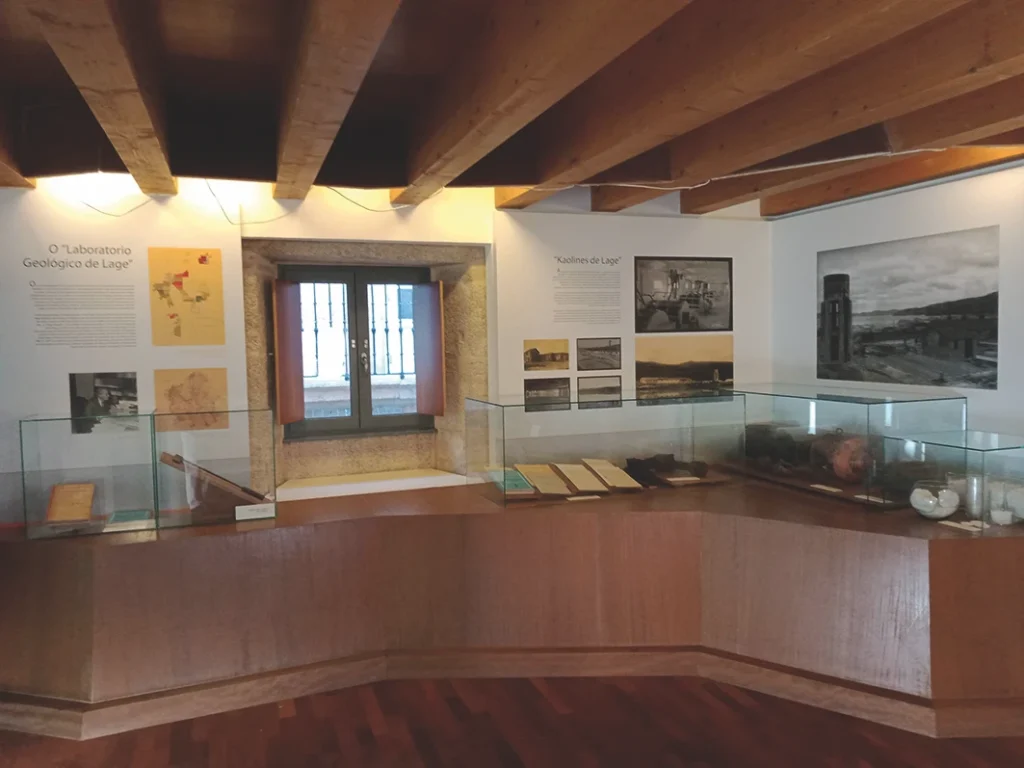
All the photos contain images of the landscapes, society, economy and leisure activities of the people of Bergantiños and Terra de Soneira in the 20th c.
From the Praza de Ramón Juega, pass under the arch and carry on up the Rúa Real to the church of Santa María da Atalaia, situated at a high point in the town, from where it dominates the port and the town centre. The church served a twofold function as a place of prayer and as a defensive strong point. A wall was built in the church atrium in the late 16th c. where several artillery pieces could be placed to defend the port.
The initial construction of the church was commissioned by Juana de Castro y Lara, on a site that may have been occupied by a church prior to the 13th c.; it was completed by her daughter Urraca de Moscoso in the late 15th and early 16th centuries. The ground plan consists of just one rectangular nave divided into three sections by pointed arches that rest on polygonal half columns that correspond to the exterior buttresses. The roof is of wood and tiles. The chancel is also rectangular and is covered with a cross-ribbed vault that rests on cluster columns with cylindrical capitals.
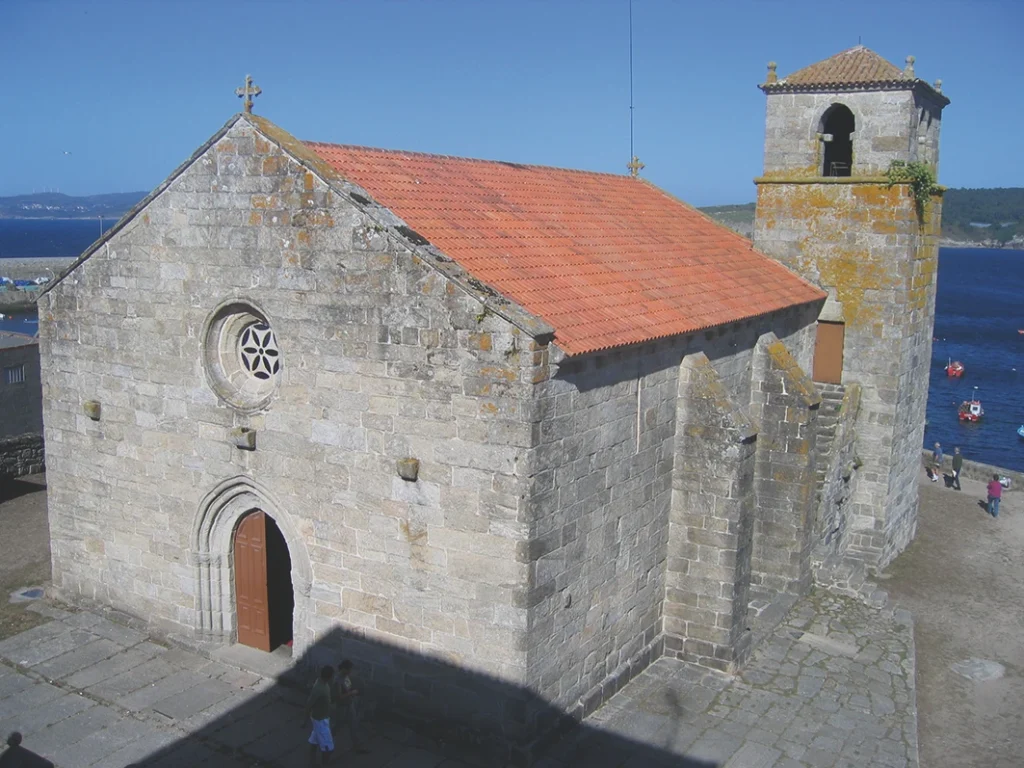
The same wall has a door with an ogival arch and large voussoirs, above which is a stone image of the Virgin. There is another door into the church in the north wall, with images of the interior frieze above the lintel, although they have been compressed due to limitations of space.
There is a door with a pointed arch in the façade, with a rose window above that illuminates the nave. The sacristy was built in the 18th c. and abuts with the east wall of the chancel; it previously occupied the lower part of the bell tower.
Enter the church and go to the chancel. There you’ll see the that the capitals of the triumphal arch have the symbols of the Castros (roundles) and the Laras (cubes), linked to the mother of Urraca, who had been the driving force behind the construction of the church.
The apse wall contains a stained-glass rose window, in which there is the polychromatic stone image of the Virxen da Atalaia (Virgin of the Watchtower), the patron saint, from the same period as when the church was built. It is similar to the image of Santa Inés (Saint Agnes) shown on the north wall, which may have been donated by Inés de Moscoso, Urraca’s sister.
Under the rose window there is a relief of the Resurrection, a sculptural work of considerable value. It is a stone frieze in the Gothic style of 4.5 x 1.07 m, which was discovered in 1955, when lightning destroyed the Baroque altarpiece that was previously there and concealed the frieze.
It shows five scenes from the Resurrection of Christ. The order from left to right is as follows: The Resurrection of Christ, the descent of the risen Christ into Limbo, the appearance of Christ before the Virgin, the Holy Women in front of the empty sepulchre and the appearance of Christ before Mary Magdalene. The scenes do not follow the chronological order that appears in the New Testament. The tombs without inscriptions next to the chancel were installed after the church was built and may belong to the Pazos family, who were vassals of the Altamiras, given that the Moscosos and Castros were buried in the church of the monastery of Santo Domingo de Bonaval in Santiago.
A fresco with an image of Santo Domingo de Guzmán (Saint Dominic) was found on the north wall in the nineteen nineties. Only the lower part of the figure can be seen, as well as a dog with a torch and a smaller image of the saint praying. The painting may be from the same period as when the church was built and may also have been commissioned by Urraca de Moscoso. The church in Laxe shares some similarities with other churches on the Costa da Morte, such as the church of Santa María de Muxía, the church of San Marcos de Corcubión and the church of Santa María das Areas in Fisterra. Some authors have listed them as churches built in the marine Gothic style.
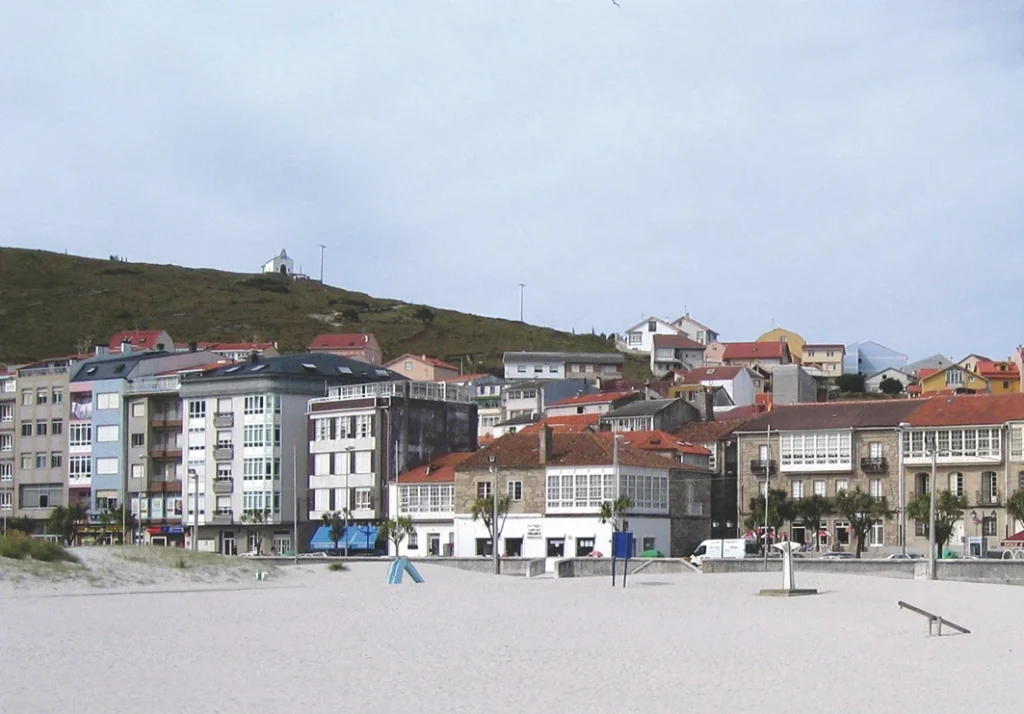
Leave the church and turn left into the Rúa Hospital, the name of which comes from the old hospital that used to be here, and which was possibly founded by Urraca de Moscoso. Carry on down the Rúa do Campo, named after the farmland in the parish, where you can see some hórreos or granaries used to store the maize harvested from the nearby fields. Then turn left towards the Fonte de Arriba fountain and from there keep walking up to the hermitage of Santa Rosa, where there are some wonderful views over the ría and town.
The origins of the chapel and calvary may lie in a sailor from Laxe, called Couceiro, who sailed on the Spain-Peru route. On his final voyage in the late 17th century, he brought with him what were supposed to be some relics of the Peruvian saint, Saint Rose, and promised that, if he arrived home safely, he would build a calvary in a high place and put the relics at the foot of the cross. The calvary is known as the Cruz do Navegante or the Cruz da Rosa, and a fiesta is held there every 21 July. The chapel was built much more recently in 1936 for the fiesta of Saint Rose, of whom a Baroque image was kept in the parish church. The pilgrimage of the saint is held on 30 August.
Head down from the hermitage along the Rúa Santa Rosa and then turn right into the Rúa Dos Plazuelas, turn left towards the Praza do Cantón or Mercado and you’re back at the promenade, the starting point of this urban route.